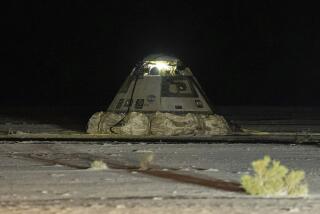U.S. Spy Satellite Heads for Fiery Death
WASHINGTON — The $1-billion U.S. spy satellite lofted into orbit by the space shuttle Atlantis last month suffered a disabling malfunction in space a week ago and is expected to make a fiery reentry, possibly over the Soviet Union, in the next 30 days, according to U.S. intelligence sources and Soviet space control officials.
U.S. officials said the heat of reentry would destroy the satellite’s major components and not compromise any of the highly classified systems aboard. But the prospect of losing the surveillance capacity of the satellite was being treated with unease in the intelligence community.
One U.S. intelligence official who was briefed on the malfunction characterized it as a “serious setback.”
The U.S. satellite, described by sources as a highly sophisticated intelligence-gathering platform, uses an advanced radar to detect Earth targets regardless of cloud cover and relay high-resolution digital images back to U.S. analysts. It was intended to stay in orbit for many years, monitoring Soviet military activities.
“Obviously any failure like that is of major concern,” said one member of Congress, also briefed on the malfunction but not on the reentry trajectory predicted by Soviet officials. “We had a string of failures in the past and had been doing pretty well, but we’re not crippled by this by any means.”
In Moscow, the Soviet news agency Novosti reported that Soviet space control officials were tracking the trajectory of four large sections of the disintegrating U.S. spy satellite, whose breakup was detected March 7.
The news agency, citing reliable sources, said Soviet officials predicted reentry over northern Soviet territory sometime between Monday and April 15.
Predicting the reentry point of a falling satellite is usually impossible until a few hours before the final plunge.
Pentagon spokesman Pete Williams in a statement Friday night said: “Space shuttle mission STS-36 achieved its goal associated with a classified DOD (Department of Defense) program. Hardware elements associated with the mission are expected to reenter the Earth’s atmosphere. We believe there is no risk to life or property.”
The Atlantis crew deployed the satellite into an extremely high northern orbit that gave it a lengthy “hang time” over the Soviet Union, where many of its sensors were trained, officials said. Such an orbit would allow the United States to monitor northern Soviet naval bases and ballistic missile silos and test ranges.
The satellite also was equipped to scoop up ground-based signals, such as missile telemetry and military and civilian communications, according to intelligence specialists.
One U.S. intelligence official called the loss of the satellite especially ironic in view of the recent retirement of the fleet of SR-71 spy planes, brought on because of their high cost and redundancy in the era of increasingly sophisticated satellites.
More to Read
Sign up for Essential California
The most important California stories and recommendations in your inbox every morning.
You may occasionally receive promotional content from the Los Angeles Times.










